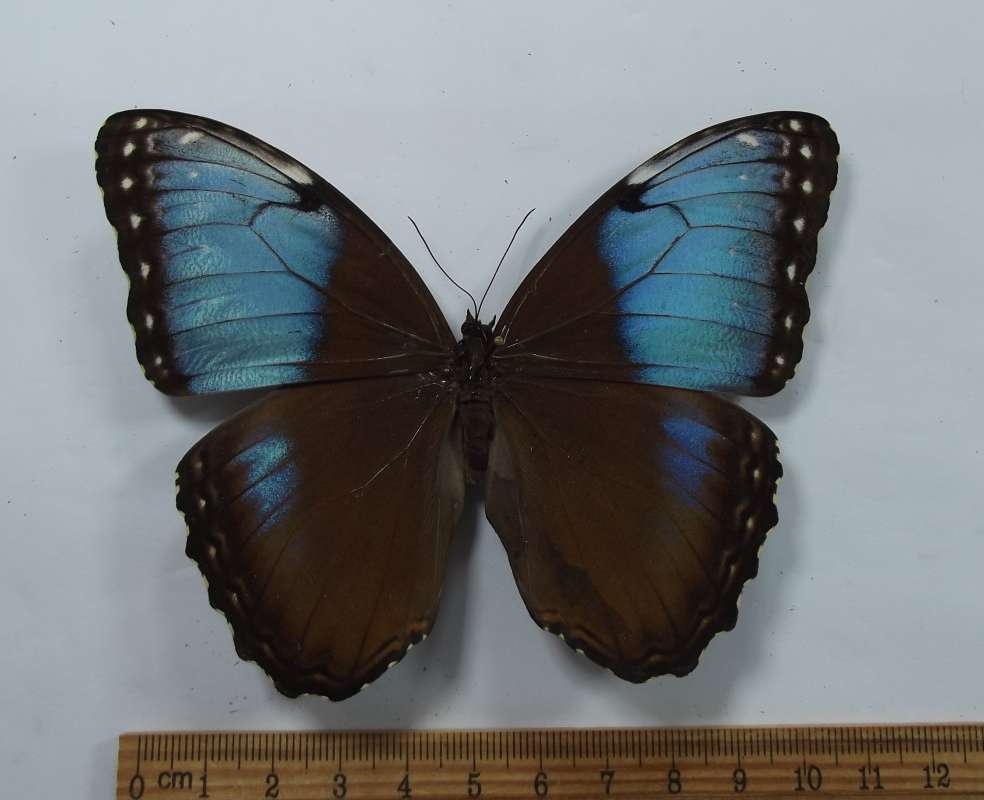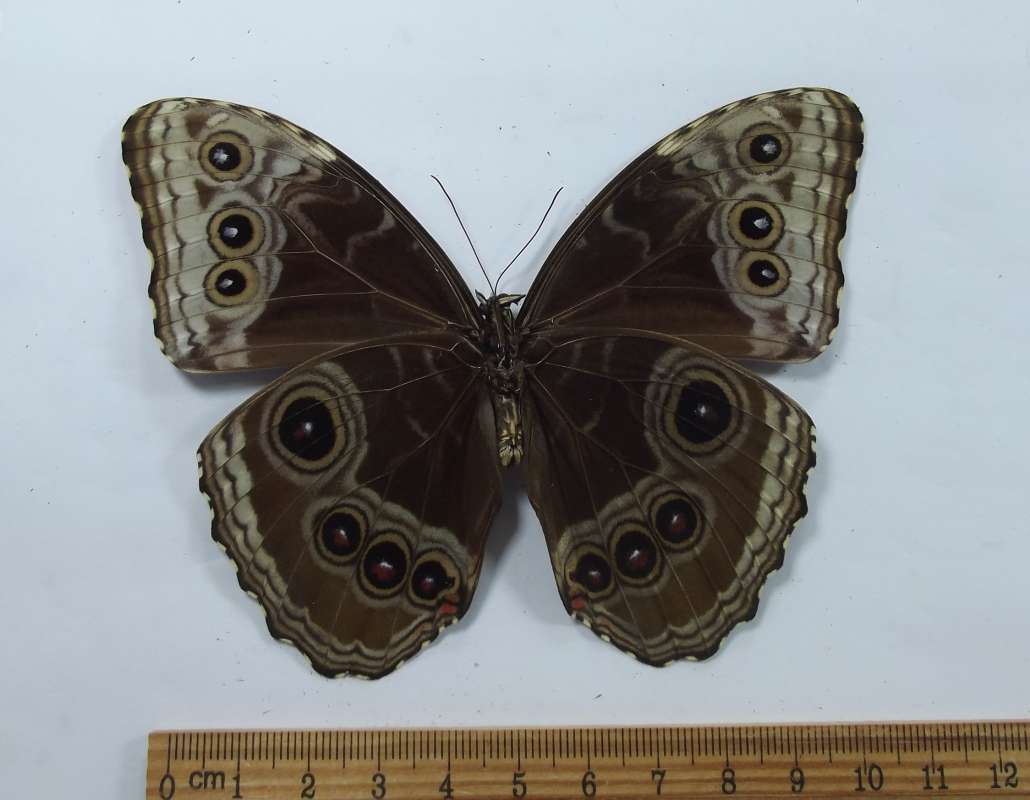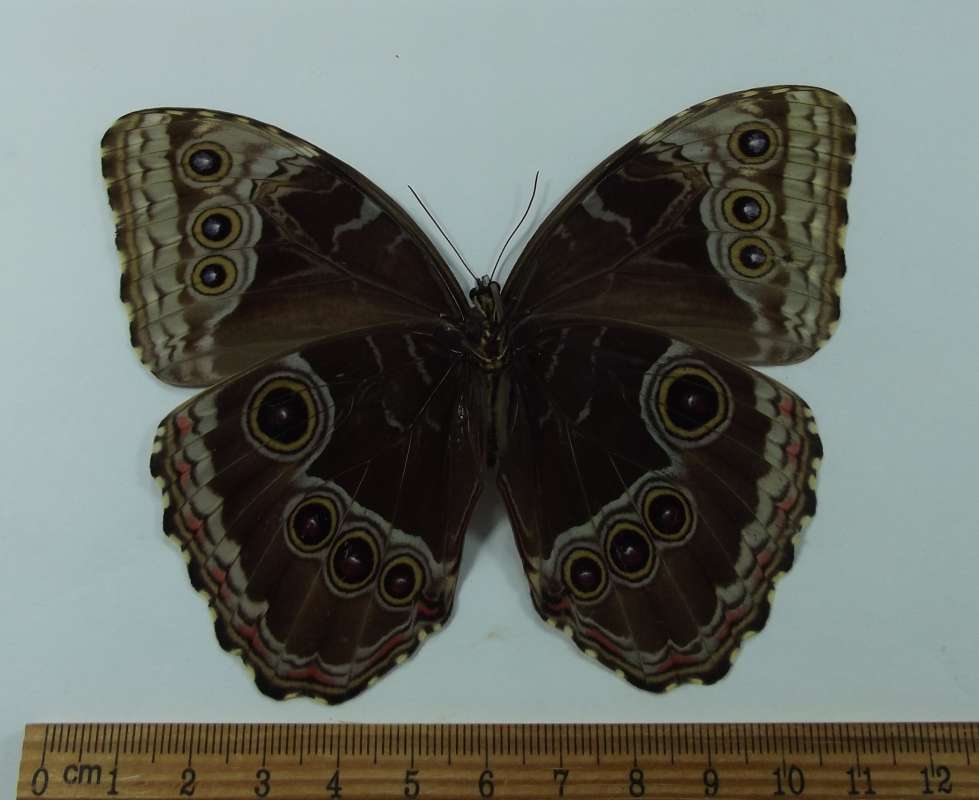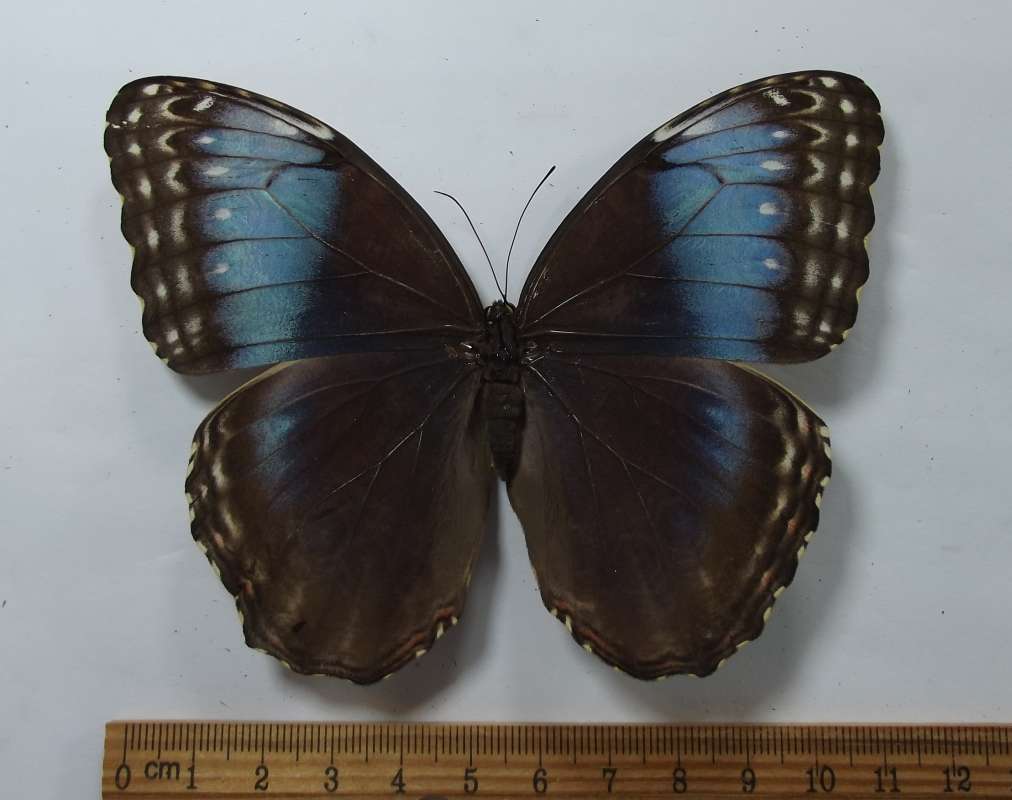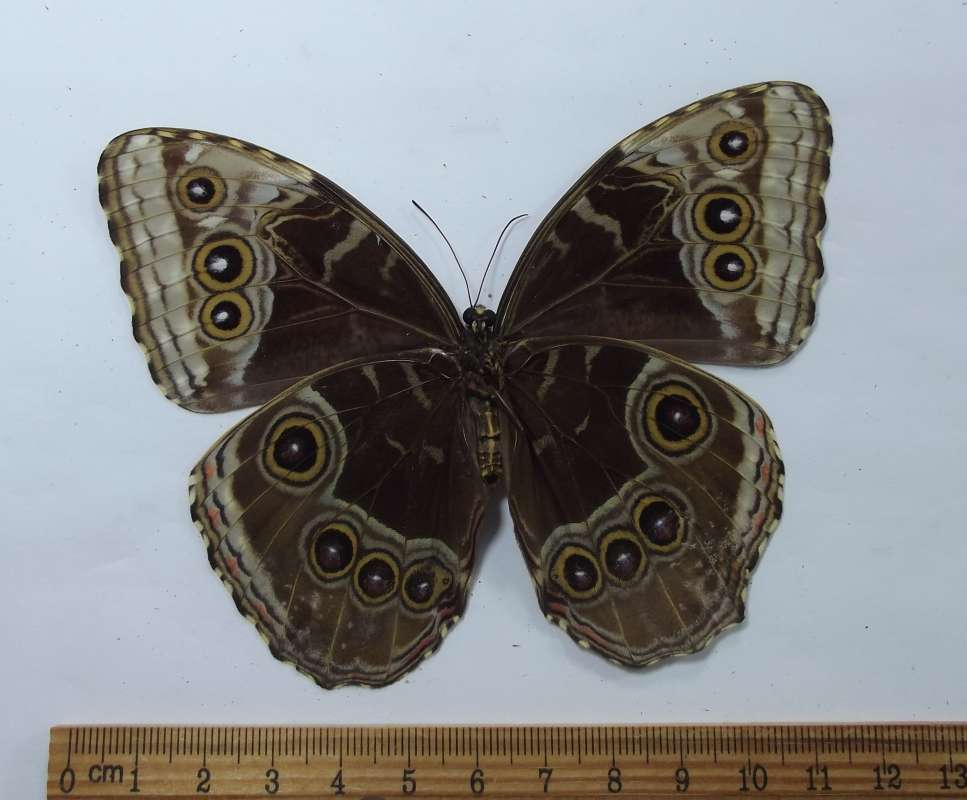SPECIES INFO
Morpho marinita is found in southern Central America. This species is unusual in the group because the typical blue band on the wings is frequently much reduced in size. However, there are quite a few different named forms for this unusual species.
In total we show three-four different forms from Costa Rica. Herein we show a pair of Morpho marinita that has but a tiny amount of blue in the rear wing.We have separated the blue-banded Morphos (Morpho achilles group and Morpho helenor group) into three different sections. This is the group that is found in Central America. The Morpho achilles group does not appear to be present in Central America, and consequently this group includes only forms in the Morpho helenor group.
We hope this will help facilitate and understand of this complex situation.
Le Moult and Real in 1962 listed the following seven species in this group:
Morpho peleides - Colombia to Ecuador
Morpho marinita - Costa Rica and Panama
Morpho montezuma - Mexico to Panama
Morpho octavia - Guatemala to Panama
Morpho hyacinthus - Mexico to Panama
Morpho corydon - Colombia and Venezuela
Morpho confusa - Colombia
Gerardo Lamas in his 2004 checklist moves all of these to subspecies of Morpho helenor and adds as follows:
Morpho cortone - Colombia (Formelry in M. peleides)
Morpho corydon - Venezuela
Morpho guerrerensis - West Mexico (Formerly in M.hyacinthus)
Morpho maculata - Ecuador (Formerly in M. peleides)
Morpho marinita - Costa Rica and Panama
Morpho montezuma - Mexico to Honduras
Morpho narcissus - Nicaragua, Costa Rica, Panama
Morpho octavia - Mexico (Chiapas), Guatemala, El Salvador
Morpho peleus(?) - Venezuela
Morpho telemon - Colombia
Morpho tucipita - Venezuela
Morpho ululina - Venezuela
Morpho zonaras - Panama (Formerly in M. octavia)
However, the large amount of material that came across my desk from south western Costa Rica (near the Panama border) caused me and several others to totally rethink either of these organizations. If one assumes if lifeforms co-exist at the same place without intermediate forms commonly present, then there are at least five species in the so-called peleides group in this material from Golfeto, Costa Rica.
Additionally, large amounts of material in the same group from northern El Salvador also arrived here. Again, if two lifeforms fly in the same place yet keep major differences in appearance, then they should be full species in their own right.
We are not suggesting the following opinions deserve revision status, but we do point out that serious research into the definition of "species" in light of all this Central America material is in order.
Morpho butterflies (Family Morphodae to Subfamily Morphiinae) are characterized by their large size and brilliant blue colors. They typically have small bodies and fly with a floating or soaring style. They are found only in the American tropics from Mexico to Southern Brazil.
Because of the brilliant blue colors, large size, and beautiful patterns, many species of these Morphos were used for art work projects from l930 to l990. Cities such as Tingo Maria (Peru), Obidos (Brazil), Santa Catarina (Brazil), and Muzo (Colombia) had networks of collectors that exported large quantities of these beautiful butterflies. Fortunately, the reproductive powers of these species were great, and the collecting seems to have had little impact on the quantity in nature. However, land clearing projects in the natural habitats will impact their populations.
This group's taxonomy is very complicated. For extensive information refer to the Le Moult and Real revision of "Les Morpho D'Amerique Du Sud Et Centrale" published by Le Moult in l962. Prior to this Le Moult revision, there were hundreds of different named forms. Le Moult reduced the species to less than 80 species, and showed that there are some cases of convergent evolution in the family and some surprising mimicry pairs.
LeMoult's work includes 672 images of which 144 are in color. Included in these 672 images are over 600 images of types. (Types are the specimens that were used when the species was first described.)
Le Moult's work has not generally been accepted by the lepidopterists community. This is no doubt partially because it is in French, and partially because the taxonomy is so complicated that many people do not have the patience to unravel the complicated problems. However, the serious butterfly student will be really rewarded when he can understand that Morpho achilles and Morpho helenor are really a mimicry pair and not sibling species.
Morphos are divided into several different subgenera. The subgenus name is used in several instances as opposed to the common term "Morpho."
We have followed the LeMoult organization, as that places similar species near each other. (When working with an alphabetical list, this complicated group gets even more complicated.)
Since 1962 when LeMoult and Real published their revision, there has been considerable additional research. We have noted the changes using the Gerardo Lamas Checklist as published in 2004. These changes are noted in the text for each subgenera. We are impressed with the inclusion in the Lamas check list of over 8 pages of Morpho synonyms with both author and date making this a very important work. Mr. Lamas notes that his personal collection and research from Patrick Blandin and others have helped in his organization.
Then Patrick Blandin published his excellent work on the Morphos. He has color pictures of almost all males, and most of the females.
Additionally, Morpho athena was described in 1966 from RJ, Brazil. Additionally, Morpho absolini has become a full species.
Butterflies and Moths (Order Lepidoptera) are a group of insects with four large wings. They go through various life cycles including eggs, caterpillar (larvae), pupae, and adult. Most butterflies and moths feed as adults, but primarily do most of their growing in the larval or caterpillar stage. Also, most species are restricted to feeding as caterpillars upon a unique set of plants. In this pairing of insects to plants, there arises a unique plant population control system. When one plant species becomes too common, specific pests to that species also become more common and thus prevent the further spreading of that particular plant species.
Although most people think of the Lepidoptera as two different groups: butterflies and moths, technically, the concept is not valid.
Some families, such as Silk Moths (Saturnidae) and Hawk Moths (Sphingidae), are clearly moths. Other families, such as Swallowtail Butterflies (Papilionidae), are clearly butterflies, However, several families exhibit characteristics that appear to be neither moths nor butterflies. For example: the Castnia Moths of South America are frequently placed in the Skipper Family (Hesperidae). The Sunset Moths (Uranidae) have long narrow antennae and fly during the day.
The Saturnidae (Silk Moths) and Papilionidae (Swallowtails) are two Lepidoptera families that have been very carefully researched as to species and subspecies. The current thinking is that if the male genitalia are alike, then the two specimens belong to the same species. As an amateur, your editor disagrees with this premise. If the genitalia are different, then no doubt two species are involved. However, if the genitalia are alike, it only proves that the genitalia are alike.
Consider Papilio multicaudata which is found in southern Canada at higher altitudes. Papilio multicaudata is found south through the Rocky Mountains as far south as Mexico City, and recently as far south as Guatemala. With different food plants, different soil types, different climates, and different seasonal patterns, it is hard to believe that this complex is all one species.
Consider capturing 100 living individuals at any life stage in Guatemala and then carrying them north to southern Canada. Would these individuals survive through several generations. If they would not survive, then this author would conclude that two different species are involved!
In the Saturnidae consider Eacles imperialis subspecies pini. This life form feeds on pines. Is not this sufficient to justify a full species status?
Note: Numerous museums and biologists have loaned specimens to be photographed for this project.
Insects (Class Insecta) are the most successful animals on Earth if success is measured by the number of species or the total number of living organisms. This class contains more than a million species, of which North America has approximately 100,000. (Recent estimates place the number of worldwide species at four to six million.)
Insects have an exoskeleton. The body is divided into three parts. The foremost part, the head, usually bears two antennae. The middle part, the thorax, has six legs and usually four wings. The last part, the abdomen, is used for breathing and reproduction.
Although different taxonomists divide the insects differently, about thirty-five different orders are included in most of the systems.
The following abbreviated list identifies some common orders of the many different orders of insects discussed herein:
Odonata: - Dragon and Damsel Flies
Orthoptera: - Grasshoppers and Mantids
Homoptera: - Cicadas and Misc. Hoppers
Diptera: - Flies and Mosquitoes
Hymenoptera: - Ants, Wasps, and Bees
Lepidoptera: - Butterflies and Moths
Coleoptera: - Beetles
Jointed Legged Animals (Phylum Arthropoda) make up the largest phylum. There are probably more than one million different species of arthropods known to science. It is also the most successful animal phylum in terms of the total number of living organisms.
Butterflies, beetles, grasshoppers, various insects, spiders, and crabs are well-known arthropods.
The phylum is usually broken into the following five main classes:
Arachnida: - Spiders and Scorpions
Crustacea: - Crabs and Crayfish
Chilopoda: - Centipedes
Diplopoda: - Millipedes
Insecta: - Insects
There are several other "rare" classes in the arthropods that should be mentioned. A more formal list is as follows:
Sub Phylum Chelicerata
C. Arachnida: - Spiders and scorpions
C. Pycnogonida: - Sea spiders (500 species)
C. Merostomata: - Mostly fossil species
Sub Phylum Mandibulata
C. Crustacea: - Crabs and crayfish
Myriapod Group
C. Chilopoda: - Centipedes
C. Diplopoda: - Millipedes
C. Pauropoda: - Tiny millipede-like
C. Symphyla: - Garden centipedes
Insect Group
C. Insecta: - Insects
The above list does not include some extinct classes of Arthropods such as the Trilobites.
Animal Kingdom contains numerous organisms that feed on other animals or plants. Included in the animal kingdom are the lower marine invertebrates such as sponges and corals, the jointed legged animals such as insects and spiders, and the backboned animals such as fish, amphibians, reptiles, birds, and mammals.
